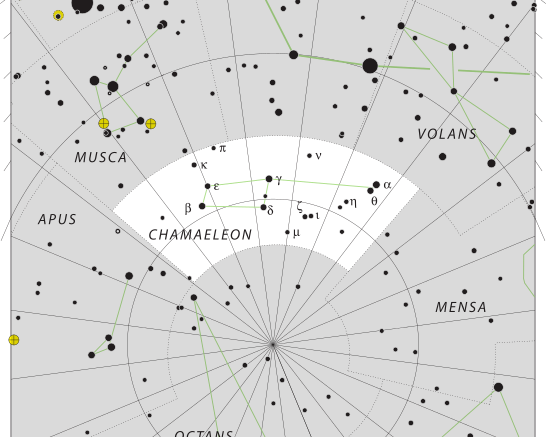Chamaeleon is a small constellation in the southern sky, and is is named after the chameleon. First created in the 16th century, chamaeleon was one of many constellations created by European explorers in the 15th and 16th centuries out of unfamiliar Southern Hemisphere stars. This constellation is not visible in the Pacific Northwest.
| Applicable Information | |
| Visibility In Pacific Northwest | Not Visible In Pacific Northwest |
| Best Times To View | Not Visible In Pacific Northwest |
| Right Ascension | 07h 26m 36.5075s–13h 56m 26.6661s |
| Declination | −75.2899170°–−83.1200714° |
| Area | 132 square degrees |
| Main Stars | 3 |
| Brightest Object | α Cha |
| Meteor showers | 0 |
| Messier objects | 0 |
| Neighboring Constellations | Musca, Carina, Volans, Mensa, Octans, Apus |
History
Chamaeleon was 1 of 12 constellations created by Petrus Plancius from the observations of Pieter Dirkszoon Keyser and Frederick de Houtman.[1] the constellation first appeared on a 35-cm diameter celestial globe published in Amsterdam in the year 1597.
In Chinese astronomy, the stars that form Chamaeleon were classified as the Little Dipper.[2] For those in Australia, Chamaeleon is sometimes also called the Frying Pan.[3]
Stars
The four bright stars in Chamaeleon form a compact diamond-shape approximately 10 degrees from the South Celestial Pole. The stars that are involved include Alpha Chamaeleontis a white-hued star, Beta Chamaeleontis a blue-white hued star, Gamma Chamaeleontis a red-hued giant star, and Delta Chamaeleontis a wide double star.
When looking at interesting deep sky objects, Chamaeleon contains one planetary nebula, NGC 3195. NGC 3195 will appear fairly faint, appearing the same apparent size as Jupiter in a telescope.
Make sure to check out other articles on the site, including a brief introduction to constellations, other constellation articles, and more!
Sources:
1 = Ridpath, Ian; Tirion, Wil (2017), Stars and Planets Guide, Princeton University Press, ISBN 978-0-691-17788-5 (p. 118)
2 = AEEA (Activities of Exhibition and Education in Astronomy) 天文教育資訊網 2006 年 7 月 28 日.
3 = “Chamaeleon Constellation”. Top Astronomer.

Be the first to comment on "Chamaeleon"